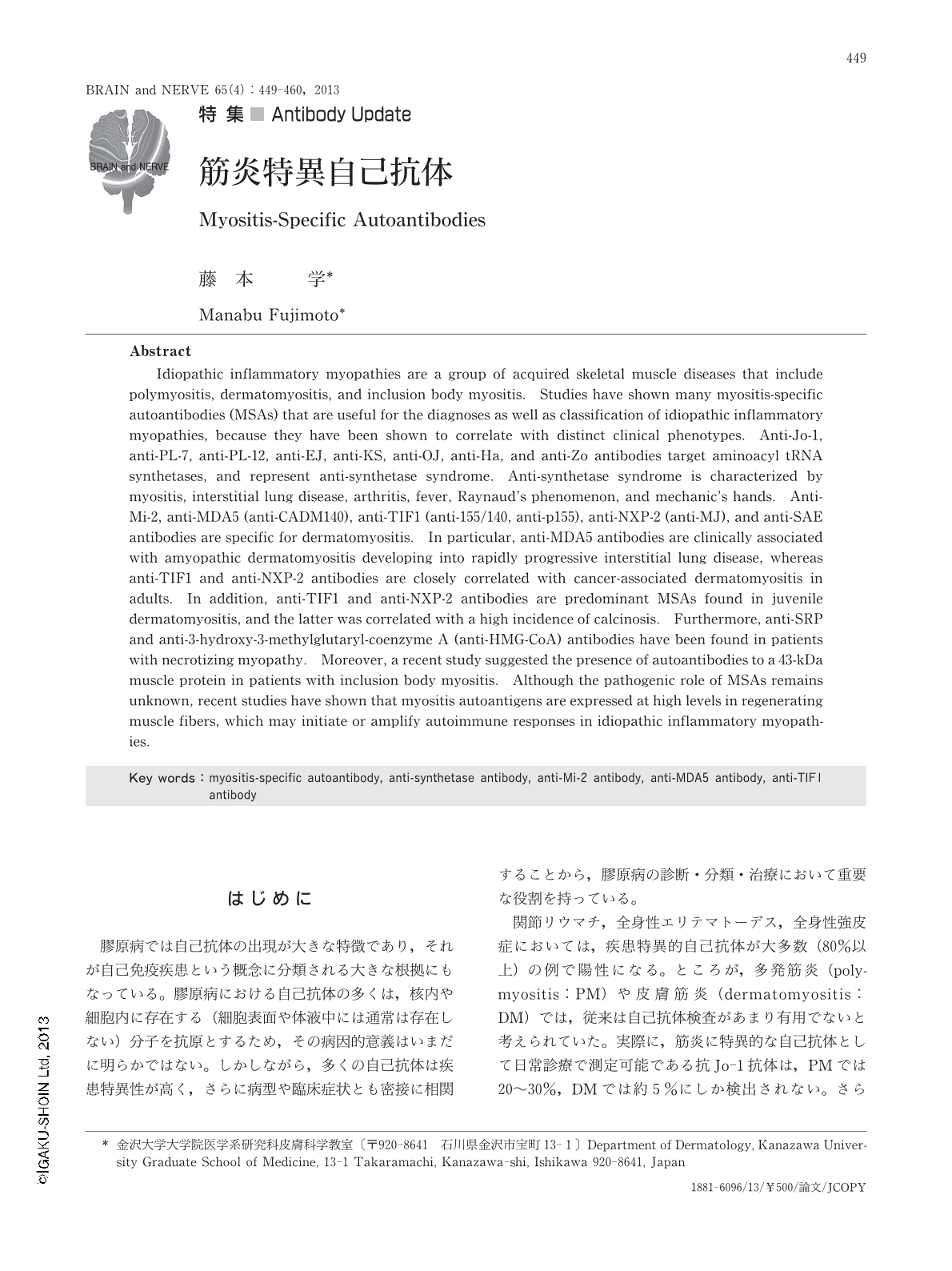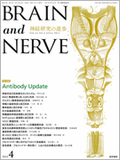Japanese
English
- 有料閲覧
- Abstract 文献概要
- 1ページ目 Look Inside
- 参考文献 Reference
はじめに
膠原病では自己抗体の出現が大きな特徴であり,それが自己免疫疾患という概念に分類される大きな根拠にもなっている。膠原病における自己抗体の多くは,核内や細胞内に存在する(細胞表面や体液中には通常は存在しない)分子を抗原とするため,その病因的意義はいまだに明らかではない。しかしながら,多くの自己抗体は疾患特異性が高く,さらに病型や臨床症状とも密接に相関することから,膠原病の診断・分類・治療において重要な役割を持っている。
関節リウマチ,全身性エリテマトーデス,全身性強皮症においては,疾患特異的自己抗体が大多数(80%以上)の例で陽性になる。ところが,多発筋炎(polymyositis:PM)や皮膚筋炎(dermatomyositis:DM)では,従来は自己抗体検査があまり有用でないと考えられていた。実際に,筋炎に特異的な自己抗体として日常診療で測定可能である抗Jo-1抗体は,PMでは20~30%,DMでは約5%にしか検出されない。さらに,蛍光抗体間接法による抗核抗体も陰性だったり低力価だったりすることが多く,これは全身性エリテマトーデスや全身性強皮症で高力価の抗核抗体が高率に陽性となるのと対照的である。
しかしながら,近年になって,PM/DMに特異性の高い新たな自己抗体が同定され,臨床的意義の解析も進んできた。このような筋炎特異自己抗体として,抗アミノアシルtRNA合成酵素(aminoacyl-tRNA synthetase:ARS)抗体,抗Mi-2抗体,抗MDA5抗体(抗CADM140抗体),抗TIF1抗体(抗155/140抗体),抗SRP抗体,抗NXP-2抗体(抗MJ抗体),抗SAE抗体などが挙げられる(Table1)1-3)。これらの抗体を合わせるとPM/DMの多くの症例で特異抗体が陽性になることになり,特にDMでは全身性エリテマトーデスや全身性強皮症と比べても遜色のない陽性率となることが明らかになった。
炎症性ミオパチーは,多様性のあるカテゴリーであり,PMとDMでは異なる発症機序が想定されている。筋症状もさまざまであり,DMの中には筋症状を欠くclinically amyopathic DM(CADM)の病型もある。また,発症年齢をとっても小児に発症するタイプと成人に発症するタイプがある。さらに,「皮膚」と「筋」以外に,悪性腫瘍と間質性肺炎という二大合併症が大きな意味を持っている。筋炎特異自己抗体は,臨床症状や合併症と密接に相関することが明らかになってきたため,このようなPM/DMの分類を考えるうえで,「自己抗体によるPM/DMのサブセット分類」が極めて有用な手段となることが明らかになってきた。すなわち,筋炎特異抗体の同定は,単に診断のみならず経過の予測や治療方針の決定においても有用であり,また,一部の抗体では抗体価が疾患活動性を反映する可能性もある。
Abstract
Idiopathic inflammatory myopathies are a group of acquired skeletal muscle diseases that include polymyositis, dermatomyositis, and inclusion body myositis. Studies have shown many myositis-specific autoantibodies (MSAs) that are useful for the diagnoses as well as classification of idiopathic inflammatory myopathies, because they have been shown to correlate with distinct clinical phenotypes. Anti-Jo-1, anti-PL-7, anti-PL-12, anti-EJ, anti-KS, anti-OJ, anti-Ha, and anti-Zo antibodies target aminoacyl tRNA synthetases, and represent anti-synthetase syndrome. Anti-synthetase syndrome is characterized by myositis, interstitial lung disease, arthritis, fever, Raynaud's phenomenon, and mechanic's hands. Anti-Mi-2, anti-MDA5 (anti-CADM140), anti-TIF1 (anti-155/140, anti-p155), anti-NXP-2 (anti-MJ), and anti-SAE antibodies are specific for dermatomyositis. In particular, anti-MDA5 antibodies are clinically associated with amyopathic dermatomyositis developing into rapidly progressive interstitial lung disease, whereas anti-TIF1 and anti-NXP-2 antibodies are closely correlated with cancer-associated dermatomyositis in adults. In addition, anti-TIF1 and anti-NXP-2 antibodies are predominant MSAs found in juvenile dermatomyositis, and the latter was correlated with a high incidence of calcinosis. Furthermore, anti-SRP and anti-3-hydroxy-3-methylglutaryl-coenzyme A (anti-HMG-CoA) antibodies have been found in patients with necrotizing myopathy. Moreover, a recent study suggested the presence of autoantibodies to a 43-kDa muscle protein in patients with inclusion body myositis. Although the pathogenic role of MSAs remains unknown, recent studies have shown that myositis autoantigens are expressed at high levels in regenerating muscle fibers, which may initiate or amplify autoimmune responses in idiopathic inflammatory myopathies.

Copyright © 2013, Igaku-Shoin Ltd. All rights reserved.


